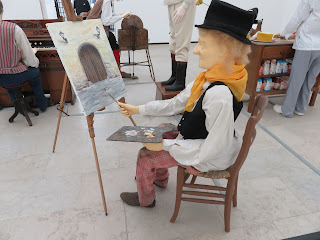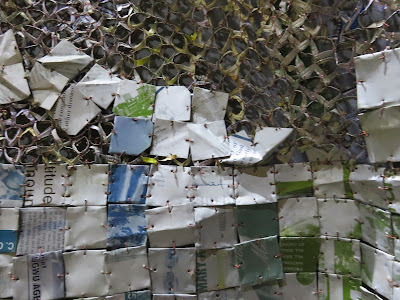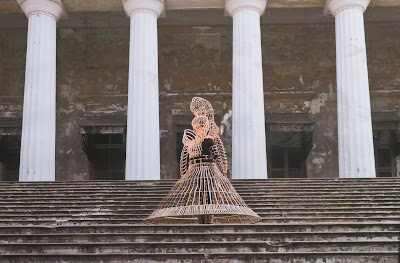My PhD focused on Italian Renaissance sculpture, but it has been years since I've followed the scholarship or engaged in discussions or debates about the subject. So while on the one hand I know more than a general audience, on the other I can't call myself an expert anymore. I had looked forward eagerly to the Verrocchio exhibition and was very disappointed. The catalogue has provided substantially more information about the works in the exhibition and it's very worthwhile, with several excellent essays. They explained some of my issues with the exhibition.
  |
David, bronze with partial gilding, Museo Nazionale del Bargello,  Florence, bronzi 450 and 451 Florence, bronzi 450 and 451 |
The label was informative about the process of completing such a large bronze, that casting was only a middle step and the entire work was patched, carved, hammered, polished, and gilded in order to become as smooth and detailed as it is. The catalogue discusses how Verrocchio may have used his experience casting bells and other large items in casting this relatively large free-standing metal sculpture. It also discusses Verrocchio's training as a goldsmith, an important aspect of Renaissance sculpture that is represented in the exhibition by a small agate covered vase and the terracotta study for a figure on the silver altar of Florence Baptistery.
 |
| Lady with Flowers, marble, Museo Nazionale del Bargello, Florence, 115.5 |
Other sculptures that caught my attention were the Putto with a Fish, a small figure that begins to twist in space, and the marble Lady with Flowers from the Bargello Museum in Florence. The Lady with Flowers is subtly carved and polished, with a slight tilt of the head and hands that seem caught in gentle motion. She was far more beautiful than I had remembered.
 |
| Giuliano de' Medici, Andrea del Verrocchio, terracotta with traces of polychromy, National Gallery of Art, Andrew W. Mellon Collection, 1937.1.127 |
More sculptures include portraits of Giuliano and Lorenzo de' Medici, a marble relief possibly of Alexander the Great,, several terracotta studies, small bronzes, and a large candlestick, many of them attributed to Verrocchio and/or assistants. The Alexander the Great is lovely white marble, perhaps a bit more precious than I like to think Verrocchio would have embraced. The portrait of Giuliano de' Medici is impressive.
 |
| Alexander the Great, Andrea del Verrocchio and Assistants? Carrara marble, National Gallery of Art, Gift of Thomas K. Straus, 1956.2.1 |
The paintings were more problematic. Gretchen A. Hirschauer and Elizabeth Walmsley in the catalogue identify two paintings as surely by Verrocchio, neither of which is in the exhibition and both of which are significantly collaborative productions. All the paintings in the exhibition are attributed to Verrocchio or supposedly influenced by him or by artists in his studio. They are half-length Madonnas in a clearly late 15th-century somewhat linear style. While these Madonnas did share many similarities, it was difficult to see those given to Verrocchio as leaders or to see why the particular works were chosen for inclusion. But here's a link to some research on a couple of them. And it led me to fantasize the exhibition curators scrambling to find appropriate paintings to fill out the exhibition.
In the center of the gallery, completely outshining this parade of half-length Madonnas is Leonardo's portrait of Ginevra de' Benci, a subtly modeled image of a specific individual, with carefully calibrated and balanced colors. I always visit this painting when I am in the National Gallery and only recently have realized how condescending her expression is. Shown here among half-length Madonnas, it looks disturbingly truncated, cut off at the shoulders and missing both arms and hands. The cut-off emblem on the reverse of the painting confirms the loss, but this context really calls it to attention.
 |
| Tobias and the Angel, Andrea del Verrocchio and assistants, The National Gallery, London, Bought 1857, NG781 |
Attributing the fish and the dog in the probably-by-Verrocchio and studio Tobias and the Angel to Leonardo seemed odd, even though those particular details are remarkably well painted. From an artistic culture where collaboration was the norm, everyone seems to be trying to select out evidence of individual genius while the catalogue insists that all the production of a Florentine studio belongs to the studio head, i.e.Verrocchio.



























































